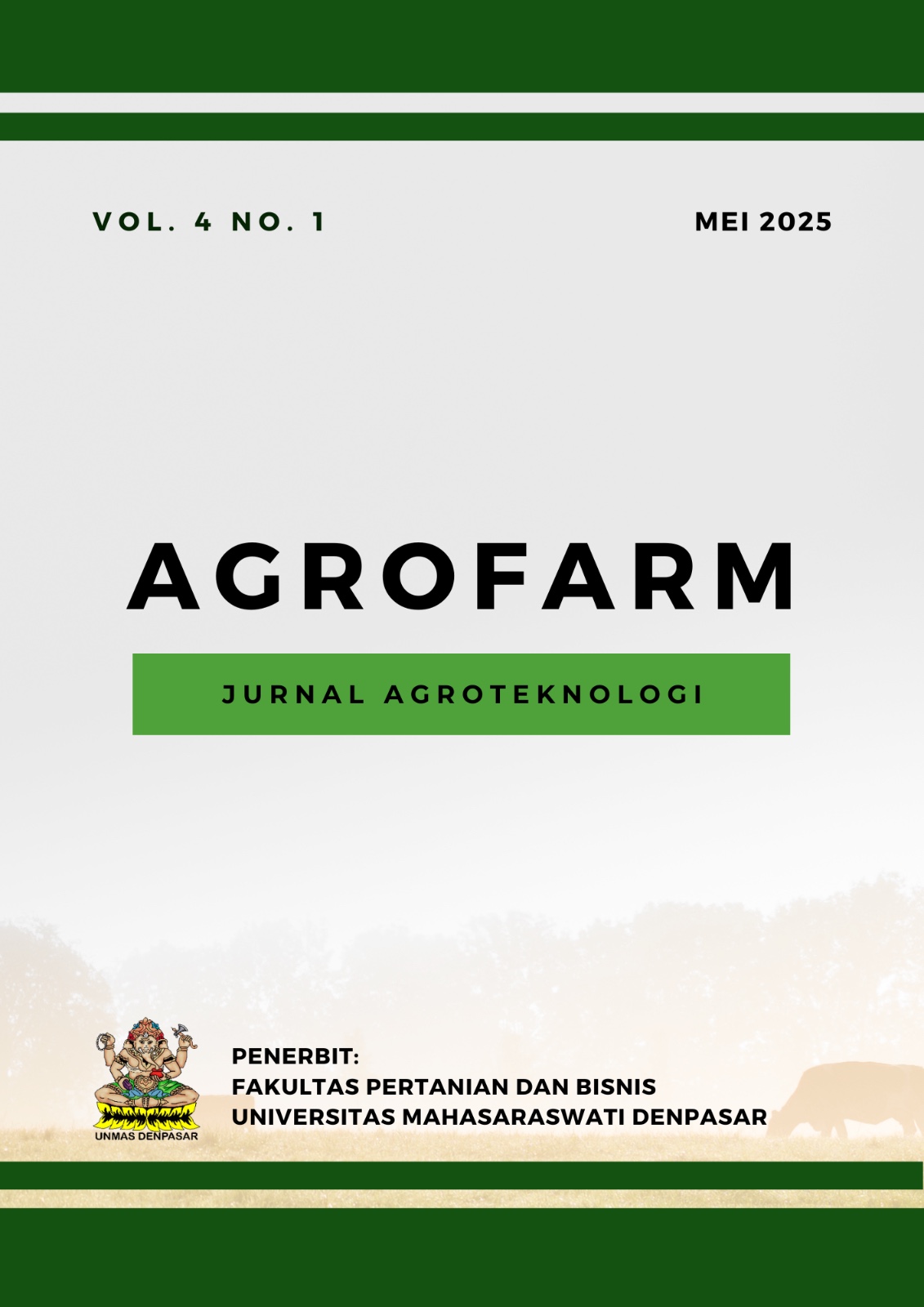EKSPLORASI KEJADIAN PENYAKIT BUSUK BUAH (Phytophthora palmivora) PADA TANAMAN KAKAO DI DESA CAU KECAMATAN MARGA KABUPATEN TABANAN
DOI:
https://doi.org/10.36733/agrofarm.v4i1.11787Keywords:
Cocoa, Exploration, Fruit Rot Disease, PathogenAbstract
This study focuses on evaluating the extent of cocoa pod damage caused by pathogenic infections. Understanding the underlying causes of disease is essential as a foundation for making effective control decisions. Field observations revealed that pod rot is the most significant disease due to the considerable losses it causes in cocoa production. Pod rot in cocoa, caused by Phytophthora palmivora, typically begins with the appearance of small brown spots on the surface of the pod around two days after infection. These lesions rapidly expand and darken, eventually covering the entire pod. Within approximately 14 days, the pod turns completely black, and the internal tissues, including the seeds, become dry and mummified, serving as a major source of future infections. White mycelium appears on the infected surface and becomes denser as the disease progresses. This mycelium produces sporangia containing numerous spores. These spores are spread by rainwater, either through direct contact or splash dispersal, infecting other parts of the cocoa tree. The time needed for the pod to rot completely is around two weeks, depending on the pod’s size at the time of infection. Field data indicated that in Plot I, 35 pods (14.28%) and 16 trees (5.33%) were infected. In Plot II, 22 pods (16.54%) and 19 trees (9.05%) were infected, while in Plot III, 15 pods (23.07%) and 9 trees (9.89%) were affected by pod rot. Environmental factors : air humidity, rainfall, and farming practices were identified as key variables that influence the rate of disease development and spread.
References
Abadi, A. (2005) Ilmu Penyakit Tumbuhan. Jakarta: Bayu Media.
Fausan, A.L. and Piner, M.I. (2013) ‘Keparahan penyakit busuk buah kakao rakyat yang berbeda naungan di Kabupaten Langkat’.
Hafsa, S., Zuyasna and Firdaus (2015) ‘Penapisan genotipe kakao tahan penyakit buah (Phytophthora palmivora) di Aceh Besar’, Jurnal Floratek, 10, pp. 79–86.
Haryono, S. (1999) Penyakit-penyakit tanaman pangan di Indonesia. Yogyakarta: Gadjah Mada University Press. [Edisi asli 1930]
Matitaputty, A.H.R.D., Amanupuyono, D. and Rumahlewang, W. (2014) ‘Kerusakan tanaman kakao (Theobroma cacao L) akibat penyakit penting di Desa Cau Kabupaten Tabanan’, Jurnal, 10(1), pp. 6–9.
Mertade, N. and Basri, Z. (2011) ‘Pengaruh diameter pangkal tangkai daun pada entres terhadap pertumbuhan tunas kakao’, Media Litbang Sulteng, 4(1), pp. 1–7.
Mulyaman, S. (2007) Metode pengamatan OPT tanaman sayuran. Jakarta: Direktorat Perlindungan Tanaman Hortikultura.
Mutulo, H.F.J., Sinaga, S., Hartana, A., Suantika, G. and Aswidinnoor, H. (2007) ‘Karakter morfologi dan molekuler isolat Phytophthora palmivora asal kelapa dan kakao’, Jurnal Littri, 3(3), pp. 111–118.
Priyanto, E. (2015) ‘Hama dan penyakit tanaman kakao (Theobroma cacao L.)’, Penyuluhan Kehutanan Kabupaten Bantul, 3(3), pp. 7–8.
Rubiyo, R. and Siswanto, S. (2012) ‘Peningkatan produksi dan pengembangan kakao (Theobroma cacao L.) di Indonesia’, Journal of Industrial and Beverage Crops, 3(1), pp. 33–48.
Semangun, H. (1990) Penyakit-penyakit tanaman perkebunan di Indonesia. Yogyakarta: Gadjah Mada University Press.
Sukanto, S. (2013) Pengendalian Penyakit. Jakarta: Penebar Swadaya, pp. 154–158.
Titus Rappan, S. (n.d.) Penyuluh Pertanian BPP Balusu Kabupaten Toraja Utara.
Windasari, N.P.E. and Budi (2013) ‘Analisis pengaruh tumpangsari terhadap pendapatan petani di Desa Cau, Kabupaten Tabanan’, Jurnal Ekonomi Pembangunan Universitas Udayana, 2(5), pp. 254–259.
Yuza, D. (2017) ‘Identifikasi patogen penyebab penyakit tanaman sawit’, Jurnal Ilmiah Universitas Batanghari Jambi, 15, p. 99.
Downloads
Published
Issue
Section
License
Copyright (c) 2025 Yohanes Berckemas, Putu Eka Pasmidi Ariati, I Putu Sujana

This work is licensed under a Creative Commons Attribution 4.0 International License.





